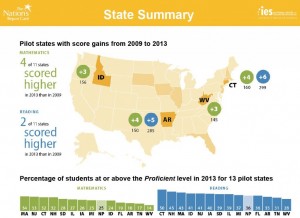Reading and math scores for Florida high school seniors remained flat between 2009 and 2013 on a respected national test, according to results released Wednesday.
 Florida’s reading scores moved from from 283 to 286 on the National Assessment of Educational Progress, better known as “the nation’s report card,” while its math scores inched up from 148 to 149. Neither increase is considered statistically significant.
Florida’s reading scores moved from from 283 to 286 on the National Assessment of Educational Progress, better known as “the nation’s report card,” while its math scores inched up from 148 to 149. Neither increase is considered statistically significant.
Nationally, NAEP scores were also flat in both subjects. In math, 25 percent of students tested at proficient or above; in reading, 36 percent. (The corresponding numbers for Florida: 19 percent and 36 percent.)
U.S. Secretary of Education Arne Duncan called the results “troubling.”
“We project that our nation’s public schools will become majority-minority this fall – making it even more urgent to put renewed attention into the academic rigor and equity of course offerings and into efforts to redesign high schools,” he said in a written statement. “We must reject educational stagnation in our high schools, and as nation, we must do better for all students, especially for African-American and Latino students.”
Unlike NAEP results for fourth- and eighth-graders, which receive widespread attention when they are reported every two years, NAEP results for 12th graders come with significant caveats.
- Only a handful of states volunteer to participate. Florida was among 11 states that participated in 2009, the first time state-by-state results were reported, and among 13 states that participated in 2013.
- The data only extends back to 2009, so there aren’t any long-term trend lines yet.
- And because it involves 12th-graders, the results can be impacted by graduation rates.
That could help explain why the national scores are stagnant at a time when graduation rates are climbing, said John Q. Easton, director of the Institute of Education Sciences.
The test sample now “includes more lower-performing students who would have dropped out in the past,” he told reporters in a conference call Tuesday. “So we’re sampling from a population that includes more weaker students than we had when the graduation rate was lower.”
Florida scores, then, would seem to be especially impacted. Over the past decade, it ranks No. 2 among states in improving grad rates, climbing 23 percentage points between 2000 and 2010, according to an Education Week analysis.
The latest NAEP results show Florida 10th of the 13 states in reading. In math, it’s 11 of 13.
Of the 13, Florida ranks second in percentage of low-income students, as measured by eligibility for free- or reduced-price lunch. Florida’s rate is 56 percent, according to the most recent federal data. The national rate is 48 percent.
Of the 11 states that participated in both testing cycles, four showed gains in math (Arkansas, Connecticut, West Virginia and Idaho) and two showed gains in reading (Arkansas and Connecticut).
The results also showed big gaps by race and gender.
In Florida, 46 percent of white seniors tested at proficient or above in reading, compared to 34 percent of Hispanic students and 16 percent of black students. Meanwhile, 41 percent of female seniors tested at proficient or above in reading, compared to 31 percent for males.
The results showed the percentage of Florida’s white students reading at proficient or above rising from 39 to 46 percent; the percentage of Hispanic students rising from 26 to 34 percent; and the percentage of black students dropping from 17 to 16 percent. None of the changes were considered statistically significant.
Florida education officials nonetheless highlighted the numbers for Hispanic students.
“The report issued today shows that Florida’s Hispanic students are definitely making progress toward closing the achievement gap,” Commissioner of Education Pam Stewart said in a written statement. “I am very proud of their hard work and thank Florida’s teachers for their exceptional dedication to student success. We need to keep the momentum moving forward to ensure our children are prepared for college, a career and life.”
In math, the results showed the percentage of Florida’s white students scoring at proficient or above rising from 24 to 26 percent; the percentage of Hispanic students remaining at 13 percent; and the percentage of black students rising from 7 to 8 percent. But again, the changes were not considered statistically significant.
Other coverage: Education Week, Washington Post, Hechinger Report, CATO, South Florida Sun Sentinel, StateImpact Florida, Gradebook.
This story is a work in progress. Check back for updates.


